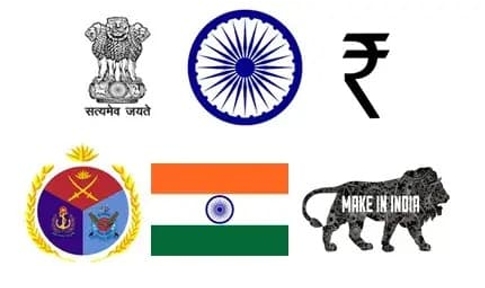- within Real Estate and Construction, Privacy and Employment and HR topic(s)
- with readers working within the Law Firm industries
Introduction
The Indian government is currently contemplating significant reforms to the legal framework governing the misuse of national symbols, particularly the national emblem, as well as the names and images of prominent political figures like the Presidents and Prime Ministers. This initiative is in response to the growing instances of unauthorized use of these symbols, which have not been adequately addressed under the existing legislations. The proposed reforms aim to introduce substantial fines and potential sentences for offenders, reflecting utmost commitment to safeguarding national integrity and dignity.
National symbols, such as emblems and flags, hold immense significance in representing a nation's identity, culture, and values. In India, the national emblem serves not only as a symbol of sovereignty but also as a reminder of the country's rich heritage and democratic principles. However, the unauthorized use of these symbols for commercial gain have become increasingly prevalent, prompting the government to consider strict regulations.

Overview of Existing Laws
The regulation of national symbols in India is primarily governed by two key legislative acts:
- Emblems and Names (Prevention of Improper Use) Act, 1950: This Act prohibits unauthorized commercial use of specific emblems and names. According to Section 3 of the Emblems and Names (Prevention of Improper Use) Act, 1950, no individual or entity can use any government trademark, design, emblem, or official seal without prior consent from the central government. The penalties for violations under this Act are relatively nominal, with fines limited to a maximum of ₹500.
- State Emblem of India (Prohibition of Improper Use) Act, 2005: This Act further strengthens the prohibition against improper use of the state emblem. Section 3 of State Emblem of India (Prohibition of Improper Use) Act, 2005 prohibits any person or entity from using the State Emblem or any imitation in a manner that creates an impression of an official association with the Central or State Government without prior permission from the appropriate government authority. Any person who contravenes the provisions of section 3 shall be punishable with imprisonment for a term which may extend to two years, or with fine which may extend to five thousand rupees, or with both or, if having been previously convicted of an offence under this section, is again convicted of any such offence, he shall be punishable for the second and for every subsequent offence with imprisonment for a term which shall not be less than six months, which may extend to two years and with fine which may extend to five thousand rupees.
Proposed Changes to Legislation
Recognizing the drawbacks of the current laws, the Ministry of Consumer Affairs has proposed several amendments to theEmblems and Names (Prevention of Improper Use) Act, 1950vide notification1 dated November 05, 2019, aimed at enhancing protection against the misuse of national emblems and names and reflecting a renewed governmental focus on safeguarding national symbols. The said proposed amendments are as under:
- Increased Financial Penalties: The Ministry of Corporate Affairs has proposed to raise the fines for first-time offenders to ₹1 lakh, which may extend to ₹5 lakh for repeat offenders.
- Imprisonment Provisions: In addition to financial penalties, the amendments include provisions for imprisonment. Offenders may face a jail term of up to six months, which marks a significant shift from the current framework which does not impose such punitive measures.
- Shifting Burden of Proof: A significant proposal includes shifting the burden of proof onto the accused, requiring to prove that the use of national symbols by them was lawful. This change contrasts with current practices where the burden lies with the State to prove the misuse.
These amendments would represent a major update to laws that have remained unchanged for over decades, highlighting an urgent need to adapt legal frameworks to modern challenges.
Proposed Amendment vis-à-vis Trademark Regime
Section 9(2) (d) of The Trade Marks Act, 1999 addresses the prohibition of trademark registration for the marks. It states that a mark shall not be registered if its use is prohibited under the Emblems and Names (Prevention of Improper Use) Act, 1950. This legislation aims to prevent the unauthorized use of certain emblems and names that are deemed sensitive or significant, particularly those associated with national symbols or religious sentiments.
The rationale behind this provision is to ensure that trademarks do not exploit symbols or names that hold particular importance or respect within society, thereby maintaining public order and preventing potential misuse or disrespect towards these symbols.
The proposed amendments in alignment to the Indian Trade Marks law will enhance the protection against the misuse of national emblems and other significant symbols. The government's intent to safeguard national emblems aligns with the Act's purpose of preventing fraudulent use and protecting the Intellectual Property.
These changes are part of a broader initiative to refine intellectual property rights (IPR) in India, reflecting the government's commitment to safeguarding national symbols from commercial exploitation.
Key Aspects of the Proposed Amendments
- Enhanced Protection for EmblemsThe amendments seek to prevent unauthorized commercial use of emblems, names, and symbols that are recognized as significant under the law. This includes national flags, seals, and other official insignia that should not be used for trade or business purposes without proper authorization.
- Integration with Trade Marks Law The amendments are intended to align the Emblems Act with existing provisions under the Trade Marks Act. This includes enhancing the penalties for trademark violations that involve these protected emblems.
- Procedural Improvements
The proposed amendments will introduce straightforward regulatory provisions, making it easier for businesses to navigate trademark registrations while ensuring that emblem protections are robust.
Conclusion
The Indian government's proposal to amend laws governing the misuse of national emblems reflects a critical response and signifies a proactive approach to address the ongoing challenges related to the protection of these essential symbols of national identity. By increasing fines and introducing potential jail terms for violators, the government aims not only to deter misuse but also to reinforce respect for India's national identity. In short, the proposed amendments in relation to the Trade Marks law and related emblem protections reflect a comprehensive effort by the Indian government to enhance legal safeguards against misuse while fostering a more conducive environment for business operations. This dual strategy is designed to harmonize protection with practicality, effectively navigating the complexities of today's dynamic commercial landscape. As discussions continue among various ministries and stakeholders, it is crucial that changes strike a balance between enforcement and fair application within India's broader legal framework, particularly concerning trademark law. The decisions made in this regard will likely shape how effectively India can safeguard its national symbols against unauthorized exploitation while fostering an environment conducive to lawful commercial practices.
Footnote
For further information please contact at S.S Rana & Co. email: info@ssrana.in or call at (+91- 11 4012 3000). Our website can be accessed at www.ssrana.in
The content of this article is intended to provide a general guide to the subject matter. Specialist advice should be sought about your specific circumstances.


